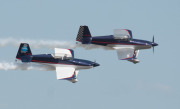Choosing the Right Shutter Speed
Posted: May 16, 2012
[caption id="attachment_10147" align="alignright" width="180"] Image credit: PCWorld[/caption]One of the most intriguing aspects of photography is that it's both an art and a science. Science tells us that, for most photos, there's a specific amount of light that will generate the "perfect" exposure--sort of like measuring chemicals in a laboratory.
Image credit: PCWorld[/caption]One of the most intriguing aspects of photography is that it's both an art and a science. Science tells us that, for most photos, there's a specific amount of light that will generate the "perfect" exposure--sort of like measuring chemicals in a laboratory.
[caption id="attachment_10147" align="alignright" width="180"] Image credit: PCWorld[/caption]One of the most intriguing aspects of photography is that it's both an art and a science. Science tells us that, for most photos, there's a specific amount of light that will generate the "perfect" exposure--sort of like measuring chemicals in a laboratory.
Image credit: PCWorld[/caption]One of the most intriguing aspects of photography is that it's both an art and a science. Science tells us that, for most photos, there's a specific amount of light that will generate the "perfect" exposure--sort of like measuring chemicals in a laboratory.
But it's not all test tubes and Bunsen burners in photography, because there are a million ways to get the right amount of light into your scene. Lots of different shutter speeds and aperture settings add up to the right exposure, for example. You're already had a chance to experiment with that using an interactive online camera simulator. And therein lies the art: No two photographers will ever capture the same scene in exactly the same way. This week, let's zero in on shutter speed and talk about how you can get a variety of different photo effects and visual styles just by varying this one camera control.
Understanding Shutter Speeds
![]()
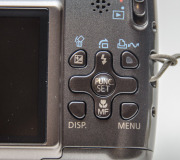 This Canon camera uses a four-way rocker to adjust exposure: up and down is shutter speed, while left and right is aperture.You probably already know that your camera's shutter speed setting controls how long the shutter is left open, and therefore how much light is allowed to reach the camera's sensor. Most cameras let you control the shutter with a dial--spin it to change the exposure time--or some sort of rocker switch.
This Canon camera uses a four-way rocker to adjust exposure: up and down is shutter speed, while left and right is aperture.You probably already know that your camera's shutter speed setting controls how long the shutter is left open, and therefore how much light is allowed to reach the camera's sensor. Most cameras let you control the shutter with a dial--spin it to change the exposure time--or some sort of rocker switch.
A slow shutter speed lets in a lot of light, but might also contribute to a blurry photo, since the sensor will register both a shaky camera and your subject's moments. A fast shutter limits the light but makes for sharper photos that freeze the action.
Terms like fast and slow are somewhat relative, of course, but as a general rule of thumb, I like to call 1/60 second the breaking point. Shutter speeds faster than 1/60, like 1/125, 1/500, and 1/2000 second are fairly fast, while 1/30, 1/15, and 1 second are slow.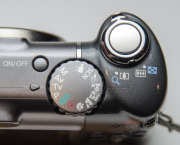
![]() The shutter priority mode on this Canon is indicated with a Tv.As I've discussed before, you can control this one critical element of your photos without worrying about balancing the exposure with a suitable aperture setting. How? By putting your camera in Shutter Priority mode. In Shutter Priority mode, you set the shutter speed and the camera does the rest. Your camera's shutter priority mode is probably indicated with an S or--if you have a Canon camera--the abbreviation "Tv."
The shutter priority mode on this Canon is indicated with a Tv.As I've discussed before, you can control this one critical element of your photos without worrying about balancing the exposure with a suitable aperture setting. How? By putting your camera in Shutter Priority mode. In Shutter Priority mode, you set the shutter speed and the camera does the rest. Your camera's shutter priority mode is probably indicated with an S or--if you have a Canon camera--the abbreviation "Tv."
Freeze the Action
Even if you don't care about any other photo techniques, you probably want to freeze action, so your kid, a car, a plane, your dog, or Bigfoot is sharp and clear. To do that, dial in the fastest shutter speed you can get. This will depend upon the available light and your camera's ISO setting, so if your shutter speed is still too slow to freeze the action, you might want to increase the ISO accordingly. (For details on ISO, check out "Understanding Your Camera's ISO Control.")
![]()
 This portrait could have been wonderful if the shutter speed hadn't been too slow.How fast is fast enough? If you are hand-holding your camera (in other words, it's not on a tripod), then a good rule of thumb is to make sure the shutter speed is faster than the inverse of the focal length of your lens. If you have a moderate telephoto lens (say, 200mm), then set the shutter speed faster than 1/200 second. That will help eliminate camera shake.
This portrait could have been wonderful if the shutter speed hadn't been too slow.How fast is fast enough? If you are hand-holding your camera (in other words, it's not on a tripod), then a good rule of thumb is to make sure the shutter speed is faster than the inverse of the focal length of your lens. If you have a moderate telephoto lens (say, 200mm), then set the shutter speed faster than 1/200 second. That will help eliminate camera shake.
Here are a couple planes that I froze at about 1/1000 second.If you're shooting a fast-moving subject, an even faster shutter is better. When I shoot cars or planes, for example, I try to push the shutter speed to 1/2000 second or better.
Panning the Action
![]()
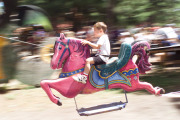 I used a shutter speed of 1/15 second to get this photo.Panning is a cool way to freeze the action while also showing how fast the subject is moving in the context of the background. The trick to panning effectively is to track the subject in the viewfinder as it moves across your field of view, keeping it centered as much as possible, then press the shutter release as it moves directly in front of you. Press and hold the shutter release--don't stab and release it--while following through and continuing to track its motion, sort of like the way a batter follows through on a swing. To get a good pan, you'll want to slow down the shutter speed, so the background blurs. You'll want to experiment to find a shutter speed that works well for you, but I suggest starting with about 1/15 second.
I used a shutter speed of 1/15 second to get this photo.Panning is a cool way to freeze the action while also showing how fast the subject is moving in the context of the background. The trick to panning effectively is to track the subject in the viewfinder as it moves across your field of view, keeping it centered as much as possible, then press the shutter release as it moves directly in front of you. Press and hold the shutter release--don't stab and release it--while following through and continuing to track its motion, sort of like the way a batter follows through on a swing. To get a good pan, you'll want to slow down the shutter speed, so the background blurs. You'll want to experiment to find a shutter speed that works well for you, but I suggest starting with about 1/15 second.
Blurring the Scene
![]()
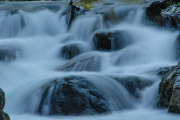 Great blurry waterfalls like this one tend to start around half a second and go slower from there.Sometimes you'll want to do the exact opposite: Instead keeping the subject sharp, you might want to completely blur it. I love blurring running water when I shoot waterfalls, for example. That can be tricky, though, because shooting waterfalls in daylight often limits how slow your shutter can go. To get shutter speeds slow enough in daylight, you should look for locations that are naturally shady, or shoot on dark, overcast, or rainy days. If all else fails, add a neutral density filter to your lens, which can reduce the light by several f/stops.
Great blurry waterfalls like this one tend to start around half a second and go slower from there.Sometimes you'll want to do the exact opposite: Instead keeping the subject sharp, you might want to completely blur it. I love blurring running water when I shoot waterfalls, for example. That can be tricky, though, because shooting waterfalls in daylight often limits how slow your shutter can go. To get shutter speeds slow enough in daylight, you should look for locations that are naturally shady, or shoot on dark, overcast, or rainy days. If all else fails, add a neutral density filter to your lens, which can reduce the light by several f/stops.
Shoot at Night
![]()
 To capture this 6-second exposure, I balanced my camera on the curb near Madison Square Park in New York.Night time is a great opportunity to leverage slow shutter speeds for compelling photos. When it comes to nighttime photos, you can shoot a variety of exposures, and no one is necessarily right--it's really a matter of taste and artistic judgment. If you're trying to get light trails, such as from car lights, try several seconds. You'll get interesting results with shutter speeds ranging from 2 to 30 seconds. Just remember that this is a situation in which a tripod is more or less essential.
To capture this 6-second exposure, I balanced my camera on the curb near Madison Square Park in New York.Night time is a great opportunity to leverage slow shutter speeds for compelling photos. When it comes to nighttime photos, you can shoot a variety of exposures, and no one is necessarily right--it's really a matter of taste and artistic judgment. If you're trying to get light trails, such as from car lights, try several seconds. You'll get interesting results with shutter speeds ranging from 2 to 30 seconds. Just remember that this is a situation in which a tripod is more or less essential.
 Biz Tip Provided by PCWorld
Biz Tip Provided by PCWorld
By Dave Johnson
